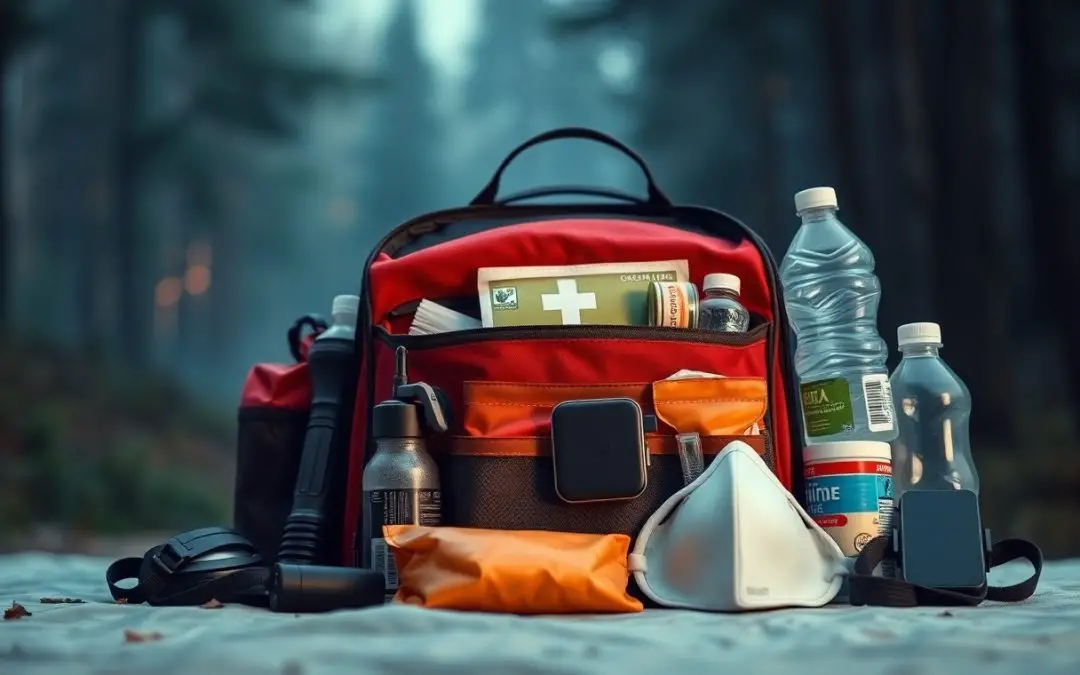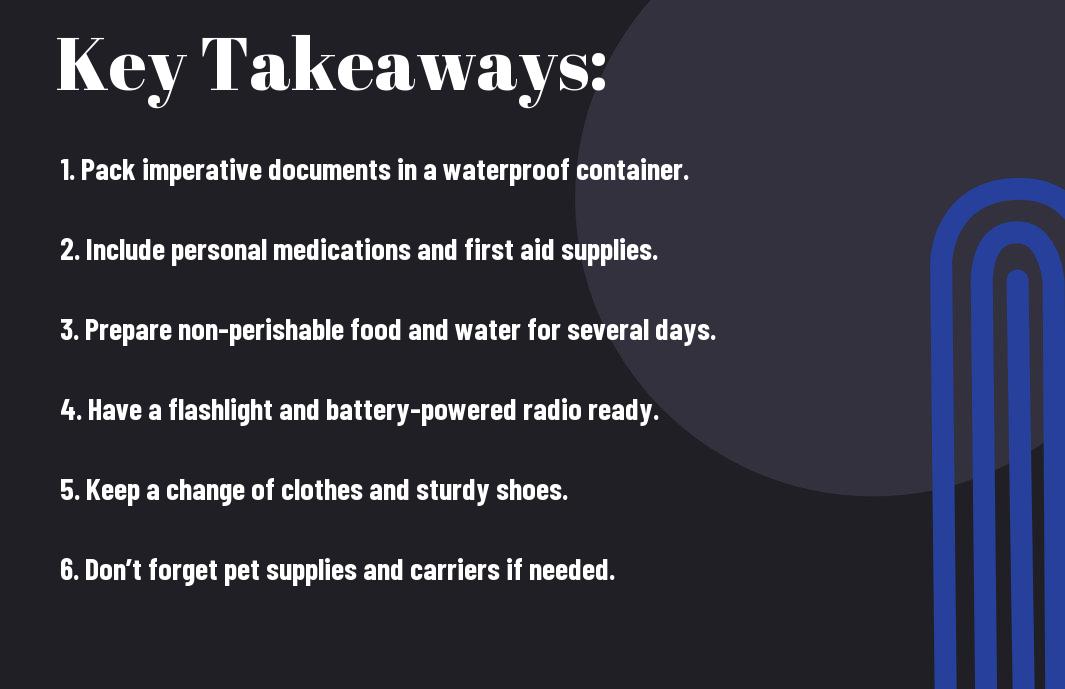Wildfire preparedness is imperative to ensure your safety during an evacuation. Knowing what to pack in a go bag can make all the difference in protecting your health and vital belongings. This guide will help you compile a practical and efficient go bag tailored to your needs, allowing you to evacuate quickly and confidently when faced with a wildfire threat. From important documents to imperative supplies, you’ll find everything you need to stay ready in the face of unexpected emergencies.
Understanding Wildfire Risks
While wildfires can occur unexpectedly, understanding their risks is vital for your safety and preparedness. Different factors, such as climate, topography, and vegetation types, can increase the likelihood of wildfires in your area. Being informed about these risks will allow you to take proactive measures to protect yourself and your property, ensuring you’re ready in the event of an emergency.
Overview of Wildfire Seasons
For many regions, wildfire seasons typically peak during warmer, drier months when vegetation is most susceptible to combustion. These seasons can vary depending on geographic location and climate patterns. By staying informed about when these periods occur, you can better prepare yourself and your go bag in advance of potential evacuations.
Identifying At-Risk Areas
Any area with dry vegetation, a history of wildfires, and proximity to urban developments is at risk. By assessing your surroundings, you can better understand your vulnerability to wildfires and the necessity for evacuation preparedness. This awareness is key to safeguarding your home and loved ones.
Understanding the specific characteristics of your neighborhood is vital when identifying at-risk areas. Familiarize yourself with local fire zones, zoning laws, and land management practices. Resources like the local fire department and emergency management agencies can provide insight into which areas are most susceptible to wildfires. Utilizing mapping tools to gauge distance from known fire-prone regions can also help you evaluate your risk level. The more knowledgeable you are about your environment, the better equipped you will be to plan and respond when wildfires threaten.
Essential Items for Your Go Bag
If you live in an area prone to wildfires, having a go bag packed with important items can be lifesaving. Your go bag should contain key supplies that can help you evacuate quickly and comfortably. Prioritize items that address your immediate needs and those of your family, including any pets. Regularly check and update the contents to ensure everything is ready when you need it the most.
Food and Water Supplies
After a wildfire evacuation is necessary, staying hydrated and having food options on hand is vital. Pack at least a three-day supply of non-perishable foods such as energy bars, canned goods, and nuts, along with bottled water. Choose items that require minimal or no preparation to simplify your evacuation process.
Clothing and Personal Items
Items like extra clothing, personal hygiene products, and necessary medications are important for your comfort and well-being during a displacement. Pack clothing suitable for various weather conditions, including sturdy shoes and warm layers. Don’t forget personal items such as toiletries, important documents, and any specific items that cater to your family’s unique needs.
With the right clothing and personal items packed, you ensure that you are prepared for any unexpected circumstances. Include a set of clean clothes for each family member and a small bag of toiletries, which may include toothbrushes, toothpaste, and sanitary supplies. Consider packing a first aid kit as well, ensuring quick access to basic medical needs when you’re on the move.
Important Documents to Include
Not having the right documents at hand can complicate your evacuation process significantly. Make sure to include imperative papers that can help you rebuild your life and prove your identity. Gather everything from identification cards to important records so you can leave quickly and confidently in the event of a wildfire emergency.
Copies of Identification
By including copies of your identification, such as driver’s licenses, passports, and Social Security cards, you ensure that you can verify your identity when necessary. These documents will be vital when dealing with authorities, emergency services, or even after you relocate to a safe area.
Insurance and Financial Records
Any records related to your insurance policies and financial information should be part of your go bag. This includes home, health, and auto insurance documents, as well as bank statements and contact information for your financial institutions.
But having easy access to your insurance and financial records gives you peace of mind during the chaos of an evacuation. These documents are imperative for filing claims and replacing lost items. Ensure that your policies are up to date and accessible, as inaccuracies can lead to delays in receiving financial assistance or benefits in your recovery efforts.
First Aid and Emergency Supplies
Keep a well-stocked first aid kit in your go bag, as it can significantly impact your safety and health during a wildfire evacuation. Be sure to include supplies for treating burns, cuts, and scrapes, along with medications for common ailments such as pain or allergic reactions. A flashlight, whistle, and basic hygiene items like hand sanitizer can also be beneficial in emergency situations. Having these supplies can help you respond effectively to both minor injuries and unforeseen circumstances.
Medical Kit Essentials
Supplies in your medical kit should include adhesive bandages, antiseptic wipes, gauze pads, and medical tape. Additionally, include a pair of gloves, tweezers, scissors, and any personal medications you require. A first aid manual can guide you through emergency responses, ensuring you have valuable information on hand. Tailoring your kit to your family’s specific needs ensures that you are prepared for any situations that may arise during an evacuation.
Fire Safety Equipment
To enhance your safety during evacuations, include fire safety equipment in your go bag. Fire blankets, smoke masks, and portable fire extinguishers are important tools that can help protect you from smoke inhalation and small flames. Keeping this equipment easily accessible will streamline your evacuation process and increase your peace of mind. Being proactive about fire safety can help you navigate emergencies with confidence.
Fire safety equipment serves as an important line of defense during wildfire emergencies. Smoke masks help filter out harmful particles, ensuring you can breathe more easily in smoky environments. Fire blankets provide a convenient way to smother small fires, while portable extinguishers give you the means to tackle flames when every second counts. By including these supplies in your go bag, you empower yourself to take action and protect both yourself and your loved ones when it matters most.
Creating a Family Communication Plan
All families should develop a communication plan that outlines how you’ll stay connected during a wildfire evacuation. This plan can significantly reduce confusion and anxiety, ensuring that everyone knows what to do, where to go, and how to reach one another in case of an emergency. Distributing roles and responsibilities among family members will also enhance your family’s preparedness and responsiveness during crises.
Establishing Emergency Contacts
Against the chaos of an evacuation, it’s necessary to have a list of emergency contacts readily available. Include family members, friends, and neighbors who can provide assistance or shelter. Ensure that everyone in your family knows how to reach these contacts, confirming phone numbers and emails. This list should be visible and easily accessible, both in your go bag and on your mobile devices.
Designating Meeting Points
Emergency meeting points are vital to ensure your family can regroup quickly and safely. Choose locations that are easy to remember and accessible, such as a neighbor’s house, a local park, or a community center. It’s wise to designate at least two meeting points: one close to your home and another farther away, in case the immediate area is unsafe. Ensure everyone is familiar with these locations and understands how to reach them during an evacuation.
For instance, when selecting your meeting points, consider accessibility and safety. Make sure each location is a safe distance from potential danger zones and allows for easy parking or walking. Discuss these spots with your family regularly so they know how to get there under stress. Using landmarks and common areas can help ensure everyone remembers the locations during emergencies, ultimately enhancing your family’s safety and communication during a wildfire evacuation.
Preparing Your Home for Wildfire Evacuations
Despite the unpredictability of wildfires, you can take proactive steps to enhance your home’s safety. Consider implementing wildfire mitigation strategies such as creating defensible space around your property, maintaining clear evacuation routes, and ensuring that your home is equipped with fire-resistant materials. By preparing your home adequately, you increase your chances of keeping your loved ones and possessions safe during an evacuation.
Fire-Resistant Landscaping
Across regions prone to wildfires, adopting fire-resistant landscaping can significantly limit a fire’s spread. You should choose non-combustible plants, maintain a defensible space by clearing debris, and use hardscaping features to create barriers. These landscaping techniques play a vital role in protecting your home while ensuring a more resilient environment against potential wildfire threats.
Home Evacuation Checklist
Home evacuation checklists help you stay organized during a stressful situation. You should prepare a thorough list of items to take, including vital documents, medications, valuables, and basic supplies. Having a clear plan ensures that you won’t overlook important belongings when time is of the essence.
And when you create your home evacuation checklist, think about what you would need both immediately and in the days following an evacuation. Include personal vitals like clothing, baby items, pet supplies, and even food and water. This checklist serves as a guide to ensure that you gather everything necessary to transition smoothly and safely, enabling you to focus on your family’s safety amid the turmoil of evacuation.
Conclusion
With this in mind, being prepared for wildfire evacuations means having a well-stocked go bag ready at all times. Include vitals such as water, non-perishable food, medications, important documents, and personal items that hold sentimental value. Additionally, ensure your bag is easily accessible and updated regularly to reflect any changes in your needs. Taking these steps can significantly enhance your safety and peace of mind in the event of a wildfire emergency.


